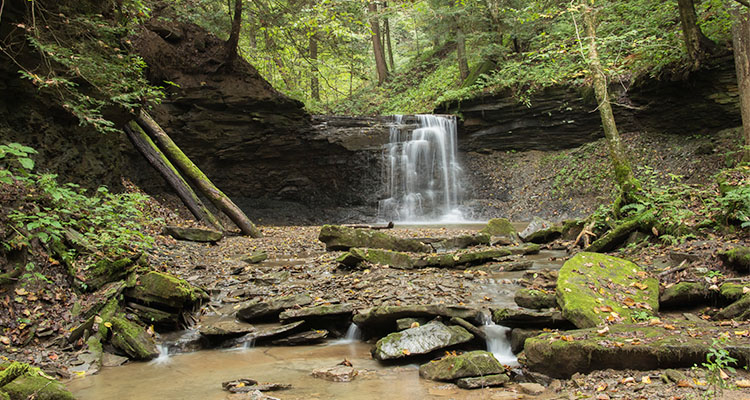However, Raven Rocks isn’t the only place to find unusual hiking. In Monroe County, just outside of Woodsfield, lies Piatt Park. It’s a little place, only 119 acres, but hidden beneath the canopy lies a rocky gorge and large recess cave (also known as a rock shelter). It’s a great place for an afternoon trip.
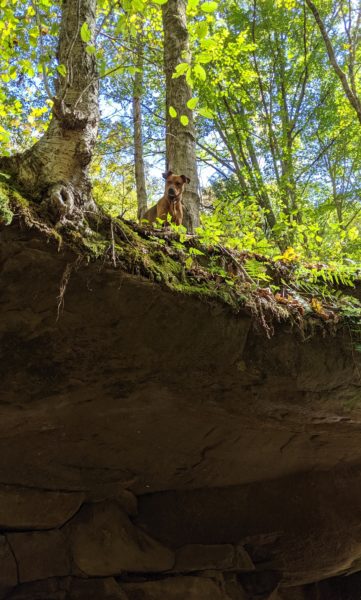
ABOUT THE PARK
The Monroe County Park board obtained the acreage from the descendants of the Piatt family in 1979. Several years later, the Park District added campsites, a picnic shelter and restrooms. All the facilities were built by the carpentry class at Swiss Hills Vocational School. The park houses 10 camping sites with electrical and water hookups, and there’s a modern playground. The bathhouse — with showers and flush toilets — is ADA accessible.
Piatt is a small place. Campsites sit close together along a cul de sac. On the south side of the park, a small wooden sign points towards the nature trail. That’s where the action is. The trail functions as an out-and-back hike with the option to turn it into a loop if you want to explore the gorge.
The stream that flows through the park has done the hard work of carving out the chasm. The rocks are sandstone, deposited over 330 million years ago when Ohio was covered by a prehistoric sea. Gorges like Hocking Hills, Raven Rocks and Piatt Park provide unusually moist environments for species you wouldn’t normally find, including eastern hemlock and Canadian yew. It’s a taste of the mountains on the Allegheny plateau.
THE NATURE TRAIL
I went on a Tuesday morning in October with my loyal hound (henceforth referred to as West Virginia Brown Dog), and we were the only souls in the park. As far as connection to the real world, there is an established well pad adjacent to the park, and I also had wireless service, though it weakened at times.
The trail leads down into the woods (we startled a deer right away) and curves around the stream that carved out the ravine. Then it proceeds uphill for less than half a mile along the rim. There’s a low rope barrier, but you’ll definitely be walking beside an edge and can look down into the depths of the gulch. (There are only so many synonyms for the word gorge, so I’m going to use them all, here.)
A series of wooden staircases leads down to both the cave and the bottom of the gorge. These are steep stairs, and on a wet day will be slippery. The first set leads to the recessed cave, and you can scramble under and over boulders for a view of a waterfall and the surrounding forest. The sheltered boulders were dry and not slippery, but there were an edge and a drop of 10 to 20 feet. W.Va. Brown Dog and I got comfortable and listened to the call of songbirds and the chatter of squirrels.
More stairs lead down to the bottom of the ravine and the stream, which was quite low due to the recent lack of rain. A waterfall seemingly ends the hike — and you can turn around here — but you’ll notice a rough path to its right that leads up into the canyon. This is where it gets more challenging. For the next quarter mile or so, the path hops back and forth over the creek. We scrambled over boulders and under logs, which required some care in where I placed my feet. Moss covers rocks, making them slick. Also, once you’re in the gorge, you have to either turn around or proceed all the way through; there are no easy exit points in the middle. To walk its length without stopping takes about 25 minutes, but of course, you’ll want to take photos, explore side canyons, and enjoy the waterfalls and pools. Just sitting and listening is nice, too.
The hike feels foreign and un-Ohio. You can move as quickly or slowly as you like, and each season offers a different beauty.
Check out this YouTube video for a drone’s eye view.
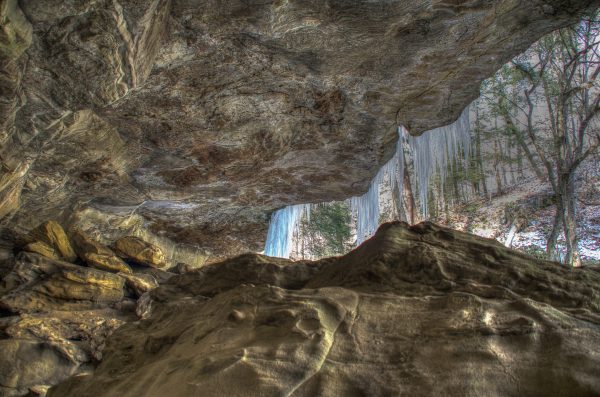
WHAT TO BRING
The hike through the gorge was rougher than I was expecting. Piatt Park’s trail requires good shoes, preferably with treads. Descending the stairs and making your way through rock and water requires careful movement. The rocks by the stream are mossy, and I slipped several times. Trekking poles or a walking stick will help. (At the same time, such implements might be a hindrance to some. Think about your mobility needs.) In the heat of summer, the gorge will be cool and the water comfortable, so water shoes might be appropriate for wading, but only when you’ve reached the bottom. Don’t even think about wearing flip-flops or wimpy sneakers with smooth soles. You’ll be on your butt faster than you can say herunterfallen.
Waterproof shoes are also helpful if you’re navigating the stream. In many places, helpful hikers have strategically placed stones to make rock-hopping easy, but that doesn’t mean you won’t make a misstep. Wool hiking socks will keep your feet warm even if they get wet, and they come in a variety of summer and winter weights.
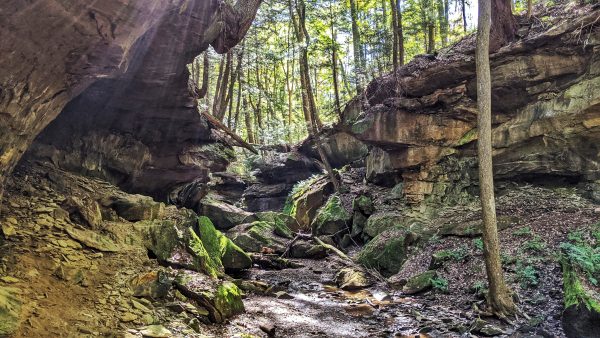 As always, it’s important to stay hydrated on a hike. It takes about an hour to do the loop, and I brought a Camelbak backpack that holds a bladder full of drinking water. I was glad I had because it left my hands free to navigate the boulders. Dogs will find a drink in the stream. (Make sure you provide water for your hound on any hike. They get thirsty, too.)
As always, it’s important to stay hydrated on a hike. It takes about an hour to do the loop, and I brought a Camelbak backpack that holds a bladder full of drinking water. I was glad I had because it left my hands free to navigate the boulders. Dogs will find a drink in the stream. (Make sure you provide water for your hound on any hike. They get thirsty, too.)
The forest is shady enough that you won’t need sunscreen. In October, I wasn’t worried about bugs, but where water flows, mosquitos may be present. Likewise, it’s important to be cognizant of ticks and to check your clothing and body after a hike.
Because we were alone, I let W.Va. Brown Dog run once we got down into the woods, but I always have her leash handy. If you bring your dog, bring a leash, especially if there are other hikers present. Also, poop baggies. It’s common decency.
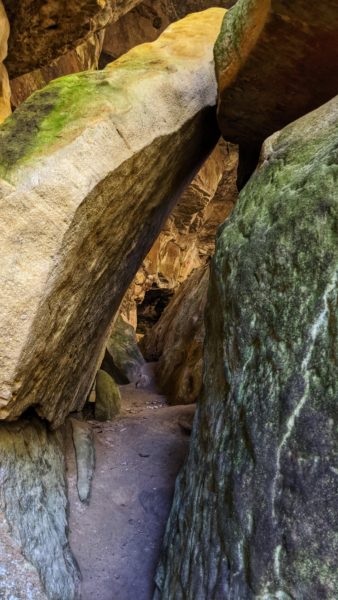 According to geocaching websites, there is a geocache located within the park. There was once a rock labyrinth downstream, but some folks online report it’s no longer there.
According to geocaching websites, there is a geocache located within the park. There was once a rock labyrinth downstream, but some folks online report it’s no longer there.
BE SMART
Like all wild places, Piatt Park presents some risks. The rocks are moss covered and very slippery. There are edges, cliffs and drops. You’ll be crossing the stream back and forth. I would not take a baby or toddler.
People with bad backs/knees/ankles and older, unsteady folks who might fall should use their best judgment. Rainy or icy days will be extra tricky. Also, though W.Va. Brown Dog is an athletic young pup, she still slipped and fell a few times. I left my senior dog at home because she has bad discs.
While you shouldn’t worry about big rocks falling, there are a few places where the sandstone is crumbly, and a half-inch slab could come loose if kicked or poked. It’s not something you’d want falling on your head, child or dog. I mention it because kids, in particular, like to knock things down; at Raven Rocks, mine whacked a 500-pound icicle, and it nearly decapitated them when it fell.
WHERE AND HOW TO FIND IT
Piatt Park lies to the east of Woodsfield, Ohio. To get there from Wheeling, take Ohio 7 south to Clarington, then follow 78 west for 12 miles. Turn right at the Piatt Park sign and then left at a second sign. Camping info is available at 740-472-1328.
Also, be aware that there’s another Piatt Park in Cincinnati. So if you pass Ohio Stadium, turn around because you’re going the wrong way.
FINAL THOUGHTS
I’m always conflicted about my One Tank Trips because I go to some wonderful places that many people don’t know about. By writing about them, I’m opening them up to more visitors. I saw half a dozen plastic bottles and coffee cups discarded along the trail at Piatt Park. That’s not too bad, as far as litter goes, but we tend to trash the places we love, don’t we? It’s why so many nature-lovers keep their favorite spots a secret.
I believe, however, that we’re better people when we’re out in nature. Nature heals our emotional wounds. It lifts our spirits. Science has proven that nature therapy is real and effective. On the trail, we chat with the person we might scream at in traffic; we stop to sit on a log we’d remove with a chainsaw if it fell in our backyard.
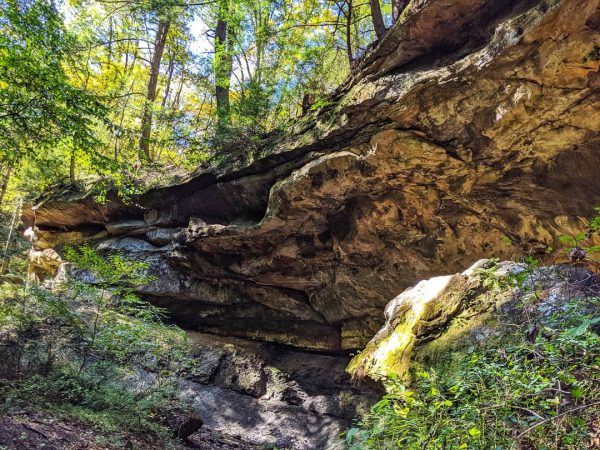
Wild places tame our hearts; they simplify life a bit. And they make their mark on our children, who need to connect with nature now so they can protect it when they’re adults in an ecologically changing world.
I share these places with you in the hopes that you will visit them and do so in reverence of the natural world around us. I hope you’ll remember that we must be stewards of the land, not masters, and that there is always hope, if we choose to grasp it.
Now get out there.
Do you have a one tank trip to share with Laura? Let us know!
• Laura Jackson Roberts is an environmental writer and humorist in Wheeling, West Virginia. She holds an MFA in creative writing from Chatham University and serves as the Northern Panhandle representative of West Virginia Writers. Her hobbies include hiking, travel and rescuing homeless dogs. Visit her at laurajacksonroberts.com.


